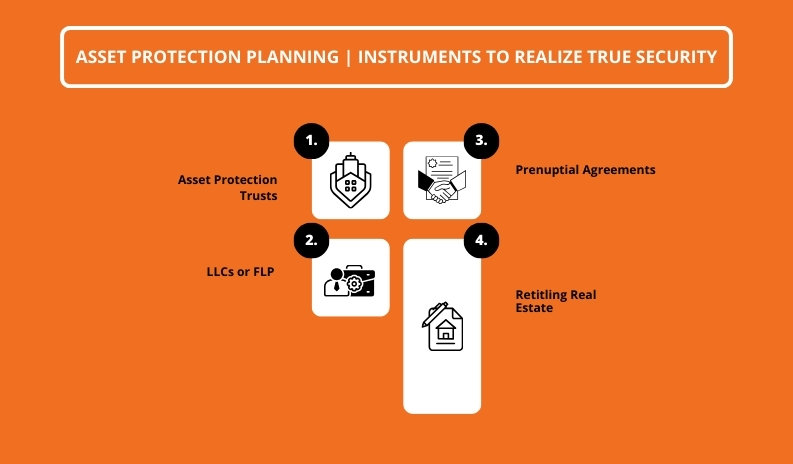Asset Protection Planning THIS Is How You Shield Your Assets!
by Mashum Mollah Finance 28 October 2024

You do not need a degree in economics or business to know what an asset is. (No, we’re not talking about the personal value you bring to the table – I know you are valuable!) This is about the assets that bring you profit or loss. And asset protection planning helps realize the former.
Asset protection is a useful method that helps protect your business or personal assets. Simply put, against taxes, legal actions and beneficiaries who contributed nothing to its acquisition!
A set of planning techniques that come in handy if you’re in a high-risk occupation or have a plethora of assets that are high value. These strategies are helpful for many business-owners and investors, so join the queue if you want to protect your assets too!
Simply follow along as we dive into the asset protection planning guide. Exploring the different ways a professional can help you shield your assets. Let’s begin the exploration with its definition and look at the tips to protect your assets at the end.
What Is Asset Protection Planning? How Does It Help?

So far, it may sound like a simple method that allows owners to take care of their property – but there’s more! Asset protection planning takes a lot of effort to determine the assets and take meticulous steps to protect those assets.
This is possible with the help of professionals who can analyze your assets and find the best method to protect your assets. Such professionals help individuals with high-value assets plan long-term protection of valuable property.
This is the first step in the comprehensive wealth defence strategy that brings extensive tools to your disposal. Moreover, asset protection planning takes wealth protection to the next level by doing everything by the books and avoiding legal judgements.
This comes as a friendly reminder when you think of throwing away your money in an offshore bank in the name of asset protection. This comprehensive plan will help you define a well-thought-out strategy that anticipates and counters legal hazards in the future.
A good asset protection plan will help you with exactly all the instruments that need to be in your kitty for the future and the steps to minimize vulnerabilities. When you go the former way – there are possible lawsuits waiting for you that can cost a ton of money!
All in all, an asset protection plan enables you to safeguard your wealth (money, property, etc.,) and gives you insight into long- and short-term steps that are necessary.
Components Of Asset Protection Planning

High-quality, truly effective asset protection planning requires more than just discussing with a legal representative. It is a thorough process that takes several month-long conversations to even think of an approach to take.
Asset protection planning requires more than just that, that is quite clear now. Several instruments help protect your assets – such as asset protection trust, prenuptial agreements, annuities, and domestic asset protection.
It is best to protect your assets before they need protection so that you do not lose out on the benefits. In addition, ensuring there aren’t any legal repercussions. The process is so lengthy that you may lose out instead of gaining from this planning.
Here are the different components of asset protection planning:
- Financial advisors who can help devise a protective and effective plan
- Knowledgeable lawyers who can help develop a secure trust instrument
- Legal advisors will help you stay vigilant against legal threats that may come your way
There is no end to planning as it is dynamic, and it changes as your financial needs evolve. This is an important factor to evaluate when considering the goals governing the planning.
Working with asset protection experts will help you make informed decisions and comprehensively understand the process. It is particularly important to have long-term plans for your company or business.
This means there will be constant changes in assets and protection plans. This flexibility in your plans can come with experts adept at changing the protection plan as per requirement.
Moreover, it is particularly important for when you’ve retired and want to set up your family for years to come. You must think practically in terms of asset protection as this planning essentially puts a degree of separation between your assets and you.
So, it is only logical to keep experts around you who can legally shelter your assets from creditors without compromising their credibility. The process is simple with them as you get valuable advice such as transferring the assets from unprotected ownership to a protected one.
Let’s look at the different forms of asset protection.
Asset Protection Planning | Instruments to Realize True Security

Out of the several instruments available for asset protection, here are a few that truly make a difference in protecting your assets. Here’s a list:
Asset Protection Trusts
Asset protection trusts are one of the most common instruments in this strategy and they can be domestic or offshore. Domestic trusts are within the US whereas offshore trusts are outside the US.
Asset protection trust works as an irrevocable trust that works as an alternative to a prenuptial agreement. These are best for those with a high net worth or professions with a higher likelihood of lawsuits. For instance, developers, and doctors.
If you are in the US, checking if your state allows setting up a domestic trust is better. If it doesn’t, going for an alternative plan would be better in comparison to setting up an offshore trust. This is because the latter costs a lot more to set up.
If you are in the following states and have high-value assets, you can consider domestic trusts as a suitable vehicle:
- Hawaii
- Alaska
- Alabama
- Connecticut
- Delaware
- Michigan
- Mississippi
- South Dakota
- Rhode Island
- Nevada
- Tennessee
- Virginia
- Utah
- Wyoming
- West Virginia
LLCs or FLP
Limited liability companies or LLCs and Family limited partnerships or FLPs are another set of instruments that help keep your assets separate from personal property. Both these options help you retain control over the asset while protecting it from creditors.
FLPs are a common vehicle to protect your assets as it transfers ownership to your children/grandchildren when you’re gone. Creating an FLP comprises establishing a general partnership, and following it up by making your heirs or family members limited partner/s.
This does not shift your authority to call the shots, however, the added members have a stake in the partnership. This translates to your estate size being smaller when considering your share.
Prenuptial Agreements
Did you know that famous prenups are a vehicle for your asset protection planning? A prenuptial agreement isn’t just preparation for the day you sign divorce papers, but a way to protect your inheritance for children.
This also protects one spouse from another’s debts – so before you get married, draft a prenuptial agreement to protect your assets.
Retitling Real Estate
Protecting property from creditors by transferring it to another person may seem wise but be careful. Most of the time, it is seen as a threat to creditors as it leaves them vulnerable.
Instead, you can think of alternative ways that are much safer such as transferring it through a trust.
Tips to Protect Your Assets | Steps of Asset Protection

If you are curious about the tips to protect your assets through an asset protection plan here are the steps:
Get in Touch with Experts
If you are new to wealth management, do not be scared, now is the best time to start. Start with your own research and look for experts in this field. Or you can ask around and contact a recommended expert who can guide you through the process.
With the best in business, you do not just get lawyers, but also trust administrators, financial advisors and all other necessary personnel. Everyone who can contribute to the planning and get it up and running will be brought into contact with professional aid.
Getting in touch with experts is necessary so that you can:
- Ask key questions and clarify any doubts. Get to know the limitations or any other detail
- Understand how asset protection strategy works
- Know all about the things necessary for this planning – for e.g., gathering asset information
Break Down your Needs and Goals
The next step is analyzing your needs and goals – both long- and short-term – so that the expert has something to work with. This step is necessary to fill in the blanks and recommend specific strategies that will work best for you.
The overriding goals for that will fit best as your needs dictate the shape your asset protection planning will take. For example, a successful business owner with several verticals under their control would want to protect their money from potential customer lawsuits.
You may also have concerns about keeping your future generations in a financially secure state. This will give rise to a goal-oriented and detailed asset protection trust in offshore jurisdictions. Why? This will help your grandchildren reap the benefits without compromising legal defenses.
Act on the Recommendation
The expert essentially oversees the last step, but you must have a clear idea about it. A good expert will keep you in the loop, so focus your time and resources on finding a knowledgeable expert.
Depending on their advice, you’ll meet with the respective bodies (for e.g., a bank in case of asset protection trust) and take necessary steps. Banks may require you to come in person and finalize the process.
Acting on the recommendation of your advisors is best in such cases as they will guide you well.
Wrapping It Up!
That was all about asset protection planning and the different components of this strategy. It is a simple process (wait for it) when you have expert guidance and clear financial goals. This takes thorough research to find the right asset protection lawyer/attorney and other relevant professionals who can do the job efficiently.
As our financial goals change with the changing market, it is only natural that the planning adapts – this happens when you have an expert with you. A professional with experience will know how to enhance your asset protection plan without inviting legal discourse.
Tell us about your asset protection journey and your thoughts on the different forms.
Additional Reading:



































































































